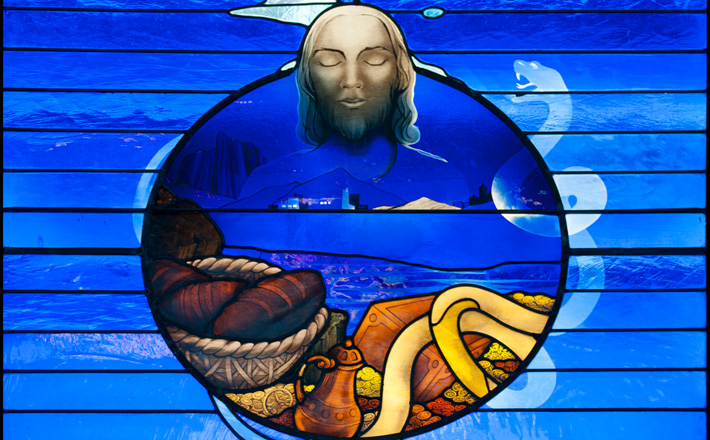Commentary on Genesis 2:15-17; 3:1-7
Tell all the truth but tell it slant — Success in Circuit lies (Emily Dickinson).1
Who tells the truth in this story: God or the serpent?
God says to Adam, “You may freely eat of every tree of the garden; but of the tree of the knowledge of good and evil you shall not eat, for in the day that you eat of it you shall die” (2:16-17). Yet when Adam and Eve eat it, they do not die. So, did God lie? Did God offer up an “alternative fact”? Did God “tell all the truth, but tell it slant?” Was God simply wrong?
The serpent — who is only presented as an animal in the story, not as Satan — says to Eve, “Did God say, ‘You shall not eat from any tree in the garden?” (3:1) We and Adam (and apparently Eve, too, though she was not yet formed when God gave the command) know that this is not at all what God said. Does the serpent also know this? We have several reasons to think it does. First, the narrator calls the serpent “crafty” or “shrewd,” implying the animal is not simply making casual conversation. Second, the serpent is indeed correct about the outcome of the humans’ snack. The snake promises that once they eat the fruit, their eyes will be opened; they will see and know. This is precisely what occurs in verse 7: their eyes are opened, and they know they are naked.
The serpent also promises that Eve and Adam will become “like gods, ones who know good and evil” (3:5).2 This outcome is not immediately confirmed in the text; however, at Genesis 3:22, God declares that the humans have indeed become “like us, knowing good and evil,” fueling God’s expulsion of the humans from the garden. Thus, the snake seems to have a lot of correct information about the garden’s trees and the consequences of eating from them — information that God either did not know or did not reveal to the humans. The serpent’s question to Eve is not exactly a lie, but in its craftiness the serpent does appear to be setting up these humans, or God, or both, for a confrontation.
In an era when “fake news” proliferates, many of us crave some straightforward answers, especially to our most deeply held questions of faith. But this text is a stark reminder that Scripture does not always provide answers, or much of anything straightforward. If we come to this story believing that God exhibits all the “omni”-categories — omnipotent, omniscient, omnibenevolent, omnipresent — then the story is going to challenge some of those assumptions. Does the snake know more than God? Is the snake more of a truth-teller than God? Those questions jar us, if we allow ourselves to ask them. Yet asking those difficult questions is one of the ways we come to glimpse the fullness of who God is, and how we might live our own lives faithfully.
In her essay “The Soil That Is Scripture,” Ellen Davis advocates reading the Bible with the virtues of humility, charity, and patience. She describes a “patient” reading of Scripture as akin to reading poetry, “ … slowing down to ponder each phrase, to wonder why this word was chosen and not another, how this line or paragraph or story builds on what precedes and leads into what follows.”3 The story of the garden is a wonderful place to practice this discipline of reading with patience. We tend to read and preach this story as if it is about one topic alone: sin. Sin is indeed a critical theme for Genesis 2-3, and I commend to you the many excellent evaluations of the topic in other commentaries.4 But this text also presents an opportunity to reflect not just on particular theological themes, but also on the sheer art of biblical storytelling.
“Seeing” and “knowing” are key words throughout the text. When Adam and Eve eat the fruit, their eyes are opened and they understand that they are naked, as discussed above. But even before partaking of the fruit, and after conversing with the serpent, Eve can see new things: “that the tree was good for food, and that it was a delight to the eyes, and that the tree was to be desired to make one wise…” (3:6). The encounter with this strange animal is already revelatory on its own. The story also connects the humans and the serpent via word choice; the word for “crafty” (‘arum), describing the serpent (3:1), is a pun on the word for “naked” (‘arummim), describing the humans (2:25). These are just a few of the elements of literary craft that reading the story “patiently” reveals.
Scripture continually challenges our presumptions about the Creator and creation alike. Every time we think we have a story figured out, something new will jump out, or our presumptions will be met with counter-testimonies. It can be difficult to bring fresh eyes to texts that are so familiar, and that are so freighted with hundreds of years’ worth of interpretation. Within the story-world of Genesis 2-3, the relationship of both God and the serpent to the “truth” is ambiguous. I do not ultimately think either God or the serpent is a liar, despite the discrepancies in each character’s speech. And yet, we must be willing to wrestle with those types of jarring questions, or else risk missing the newness, wonder, and possibility that listening to and for God’s word can bring.
The Bible is not the place to go if you want, like Joe Friday in the old TV show “Dragnet,” “just the facts, ma’am.” The Bible is not a collection of facts. It is a collection of stories, poems, songs, prayers, and remembrances. It invites us to dwell over its details, revel in its beauty, and reflect on its difficult questions. The wonder of biblical storytelling is itself worthy of proclamation.5 In the Dickinson poem quoted at the beginning of this commentary, telling the truth “slant” is not advocacy for trying to pull the wool over the eyes of our neighbors. Instead, Dickinson describes Truth — with a capital T — as so “dazzling” that we must receive it “gradually,” or else be blinded by its grandeur. Perhaps this is why Scripture is often such a puzzle; the fullness of God’s Truth is too much to chew in one bite.
Notes:
1 For the full text of this poem, see https://www.poetryfoundation.org/poems-and-poets/poems/detail/56824.
2 Both singular and plural translations (“like God” or “like gods”) are grammatically defensible here, but the plural more closely parallels the plural echo in 3:22, “like us.”
3 Ellen F. Davis, “The Soil That is Scripture,” in Engaging Biblical Authority: Perspectives on the Bible as Scripture (ed. William P. Brown; Louisville: Westminster John Knox, 2007), 36-44.
4 The Working Preacher commentaries by Juliana Claassens (https://www.workingpreacher.org/preaching.aspx?commentary_id=1978), Dennis Olson (https://www.workingpreacher.org/preaching.aspx?commentary_id=868), and Frank Yamada (https://www.workingpreacher.org/preaching.aspx?commentary_id=35) are very helpful in this regard, either by tackling the question of sin or offering up additional, related themes.
5 For more on biblical wonder, see the excellent book by William P. Brown, Sacred Sense: Discovering the Wonder of God’s Word and World (Grand Rapids: Eerdmans, 2015).


March 5, 2017